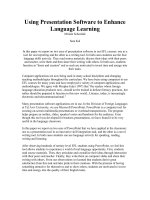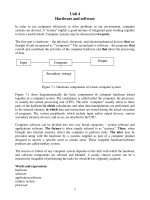Software Maintenance
Bạn đang xem bản rút gọn của tài liệu. Xem và tải ngay bản đầy đủ của tài liệu tại đây (8.54 MB, 20 trang )
Software Maintenance
Software Maintenance
WHAT IS SOFTWARE MAINTENANCE
Any work done to change the software after it is in
operation this include:
Error corrections
Enhancements of capabilities
Deletion of obsolete capabilities
Optimization
The purpose is to preserve the value of software over
time
CATEGORIES of MAINTENANCE
Corrective Maintenance: refers to modifications
initiated by defects in the software
Adaptive Maintenance: includes any work initiated
as consequence of moving the software to a difference
hardware or software platform-compiler, operating
system or new processor.
Perfective Maintenance: refers to enhancements
such as making the product better, faster, smaller,
better documented, cleaner structured.
Preventive Maintenance: the purpose is making
program easier to understand and hence facilitating
future maintenance work.
PROBLEMS DURING MAINTENANCE
Difficult to have the persons, who were constructed
the program
The program is changed by person, who did not
understand it clearly
Program listings are not structured to suppose
reading for comprehension.
The systems are maintained by the persons who are
not original authors.
There is the information gap between user and
developer
The systems are not designed for change.
POTENTIAL SOLUTIONS to MAINTENANCE
Budget and Effort Reallocation: It is suggested that
more time and resources should be invested in
development specification and design of more
maintainable systems rather than allocating resources
to develop unmaintainable or difficult to maintain
system.
Complete Replacement of an exist System if the cost
for maintaining as much as developing a new one.
Maintenance of existing system.
MENTENANCE PROCESS
Program Understanding: Analyzing the program in
order to understand it.
Generating Particular Maintenance Proposal to
accomplish the implementation of the maintenance
objective.
Accounting for all ripple effects as a consequence of
program modifications.
Modified Program Testing to ensure the modified
program has at least the same reliability level as
before.
MENTENANCE MODELS
Quick-Fix Model
The fire fighting approach
Waiting for the problem to occur and then trying to
fix it as quickly as possible.
Fixes would be done without detailed analysis of the
effects.
In an appropriate environment it can work perfectly
well e.g. The system is developed by a single person.
Redesign current
version and
implementation
Characterize
proposed
modifications
MENTENANCE MODELS
Iteractive Enhancement Model
The model based on the
existing of documentation.
Three states:
Analysis the exist system
Characterize proposed
modifications
Redesign and
implementation
Analysis the exist system
MENTENANCE MODELS
Reuse Oriented Model
The maintenance could be viewed as an activity
involving the reuse of existing program components.
Identification of the parts of the old system that are
candidates for reuse
Understanding these system parts
Modification of the old system part appropriate to the
new requirements
Integration of the modified parts into the new system.
Approved change
Result
MENTENANCE MODELS
Boehm’s Model
Based on the economic models and principle
Proposed changes
Change Implementation
Change Implementation
Management decisions
Management decisions
New version of
software
Software is use
Software is use
Evaluation
Evaluation
MENTENANCE MODELS
Taute’s Model
Change request
Change request
Estimate
Estimate
Schedule
Schedule
Program
Program
Test
Test
Documentation
Documentation
Operation
Operation
Release
Release
ESTIMATION OF MAINTENANCE COST
Belady and Lahman Model: The effort and cost can
increased exponentially if the poor software development
approach is use and the person or group that used the
approach is no longer available to perform maintainance.
M= P + Ke
(c-d)
M: Total effort expended
P: productive effort that involves analysis , design, coding,
testing and evaluation
K: an empirically determine constant
c: Complexity measure due to lack of good design and
documentation
d: degree to which maintenance team is familiar with the
software.
ESTIMATION OF MAINTENANCE COST
Boehm Model: used a quantity call Annual Change
traffic (ACT) which is defined as:
The Annual Maintenance Effort (AME) in person-
month calculated as: AME = ACT + SDE
SDE: software development effort in person-month
KLOC
KLOCKLOC
total
deletedadded
ACT
REGRESSION TESTING
Regression testing is the process of retesting the
modified parts of the software to ensure that no new
errors have been introduced into previously tested
code.
Development Testing versus Regression Testing
S.no. Development Testing Regression Testing
1. We create test suite and test plan We can make use of existing test suite
and test plan
2. We test all S/W components We test modified components or
components affected by modification.
3. Budget gives time for testing No time (performed in crisis situation)
4. Once on S/W product Many times
REVERSE ENGINEERING
Reverse engineering is the process followed in order to
find difficult, unknown and hidden information about
a software system. It is become important since
several software products lack of documentation and
are highly unstructured.
Scope and Stacks: the main purpose is to recover
information from existing code or any other
intermediate documents, any activity that requires
program understanding at any level.
REVERSE ENGINEERING (2)
Application of Reverse Engineering:
i. Program comprehension.
ii. Redocumentation and/or generate documentation.
iii. Recovery of design approach and design detail at any
level of abstraction.
iv. Identify reusable components.
v. Identify components that need restructuring.
vi. Recovering business rules.
vii. Understanding high level system description.
SOFTWARE RE-ENGINEERING
The old systems that must still be maintained are
sometimes called legacy systems.
Software re-engineering is concerned with taking
existing legacy system and re-implementing them to
make them more maintainable. This maybe include
re-documented and re-structured.
Software re-engineering allow us to translate source
code to new language, restructure our old code,
migrate to a new platform (such as client/server),
capture and then graphically display design
information, and re-document poorly documented
system.
SOFTWARE RE-ENGINEERING (2)
Different between re-engineering and new software
development:
System
specification
Design &
Implementation
New system
Existing
software system
Understanding
&
transformation
Re-engineering
system
New software system
Re-engineering
DOCUMENTATION
User Document: refers to documents which containing
description of the functions of a system without reference
to how these functions are implemented.
System overview
Installation guide
Beginner's guide
Reference guide
Enhancement guide
Quick reference card
System administration
DOCUMENTATION
System Document: refers to documents which containing
all facets of system, include analysis, specification, design,
implementation, testing, security, error diagnosis, and
recovery
System Rationale
SRS
Specification /design
Implementation
System test plan
Acceptance test plan
Data dictionaries









